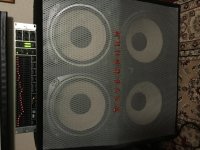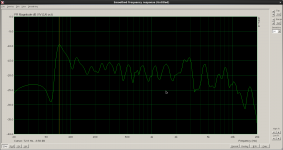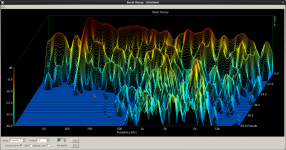Hi,
I think everyone has a favourite full range somewhere. However I am looking at full rangers where if it used by itself is not impressive,maybe a lot of peaks and valleys but if you decide to equalise them via DSP or tone controls, becomes a new thing altogether.
For example you may find a speaker very shouty, but after equalisation the speaker might be very detailed without the shoutiness.
As for myself, I have been messing around with a Faitalpro 3Fe22. However the frequency response tend to be on the rising end with increasing with frequency. This makes the speaker sound a bit thin. However once equalized via DSP, they prove to be extremely detailed and very pleasant to listen to.
Any thoughts?
Oon
I think everyone has a favourite full range somewhere. However I am looking at full rangers where if it used by itself is not impressive,maybe a lot of peaks and valleys but if you decide to equalise them via DSP or tone controls, becomes a new thing altogether.
For example you may find a speaker very shouty, but after equalisation the speaker might be very detailed without the shoutiness.
As for myself, I have been messing around with a Faitalpro 3Fe22. However the frequency response tend to be on the rising end with increasing with frequency. This makes the speaker sound a bit thin. However once equalized via DSP, they prove to be extremely detailed and very pleasant to listen to.
Any thoughts?
Oon
Generally rising or falling responses are good candidates to be fixed by DSP or tone controls. Maybe one or two peaks at the end of the bandwidth are ok. But you don't want to start with a driver that has several peaks and valleys, because you will never be able to perfectly EQ out the resonant behavior.
I've read good things about the 3Fe22. Of course the Vifa TC9 is the star performer here. Others in the Peerless range are not bad either, TG9 others. And the Scan Speak 10F range is good too.
I've read good things about the 3Fe22. Of course the Vifa TC9 is the star performer here. Others in the Peerless range are not bad either, TG9 others. And the Scan Speak 10F range is good too.
Hi ra7,
Agreed on not too much fixing. What I meant was, if you could take frequency response out of the consideration and you could now focus on other parameters, transient response, uncontrolled resonance, details, microtexture, imaging will now come into play. What would be then your favorite speaker. Can be a large speaker too like an 8". Not necessarily a 3-4 inch.
Agreed on not too much fixing. What I meant was, if you could take frequency response out of the consideration and you could now focus on other parameters, transient response, uncontrolled resonance, details, microtexture, imaging will now come into play. What would be then your favorite speaker. Can be a large speaker too like an 8". Not necessarily a 3-4 inch.
Well, the other thing you cannot fix with EQ is dispersion. An 8" driver will start beaming around 1700 Hz. Some people like that sound with no reflections, but most prefer the late arriving reflections from wide dispersion. Even the Vifa TC9, which is a 2.5" driver starts beaming around 6 kHz or so. Not ideal, but not too bad.
Well, the other thing you cannot fix with EQ is dispersion. An 8" driver will start beaming around 1700 Hz. Some people like that sound with no reflections, but most prefer the late arriving reflections from wide dispersion. Even the Vifa TC9, which is a 2.5" driver starts beaming around 6 kHz or so. Not ideal, but not too bad.
My thoughts on the beaming issue when it comes to small full range, it can be solved by putting the speaker at an angle so it crosses at the listener. And another speaker facing outwards to get the reflections off the wall. Bose used to do that with their AM5 and the Jewel cube system. The Jewel cube sounded not bad, but the AM5 didn't have any sparkle in the sound.
The soundstage was really huge though. I am not impressed at all with the present day Bose system and their new satellites.
Some people just add in a rear firing tweeter. For myself I added in a rear firing ribbon tweeter with an extra amp with a 30ms delay via DSP.
But you are correct in that many qualities can't be corrected by DSP. But I would like to highlight that what I am interested in is other qualities of the speaker driver if we could correct for the frequency response. I am not debating the pros and cons of using DSP with full range drivers.
For example, I own the SEAS FA22RCZ as well. You could try boosting the treble all you want but the treble just doesn't have the sizzling quality. On the other hand, I also have the Dayton Audio PS-220-8. That speaker has real treble. even without any boosting.
My two cents.
Oon
Dear Dave,
Would love to try your enabled speakers one day. I still have a log queue of speakers seeking my attention. I sometimes think this might be how the emperor of China feels with his 1000 concubines.
You should consider giving the Faitalpro 3 Fe22 a shot with the enabled treatment. I can just imagine, the bright yellow dots against a black background.
I have the original Alpair 6. I haven't played with it for a while. I think I should take it out and see how it compares...
OOn
Would love to try your enabled speakers one day. I still have a log queue of speakers seeking my attention. I sometimes think this might be how the emperor of China feels with his 1000 concubines.
You should consider giving the Faitalpro 3 Fe22 a shot with the enabled treatment. I can just imagine, the bright yellow dots against a black background.
I have the original Alpair 6. I haven't played with it for a while. I think I should take it out and see how it compares...
OOn
In the case of a hi-Q resonance you can make it essentially flat with EQ, but the resonance is still there. To properly tackle such a resonance you need to do it at the source.
Exactly!
Then after damping sharp resonances at the source, something can be done (-24 dB from top to bottom, i.e. some settings are at -13 dB). ;-)
Attachments
You should consider giving the Faitalpro 3 Fe22 a shot with the enabled treatment. I can just imagine, the bright yellow dots against a black background.
It is on my list of drivers to try out when i can afford it.
I have the original Alpair 6. I haven't played with it for a while. I think I should take it out and see how it compares...
This is a 1st generation driver, all of Mark’s 2nd & 3rd generation are a big step forward.
dave
It is on my list of drivers to try out when i can afford it.
This is a 1st generation driver, all of Mark’s 2nd & 3rd generation are a big step forward.
dave
Hi Dave,
I think the Faitalpro Neos are going for only $32 at PE. The ferrites about $10 cheaper.
Hmm.. interesting to note on MA drivers. What's the main difference between the second generation and first generation in the terms of sound quality?
I've hear the SB acoustics aluminium cones are pretty good as well with the slits. Heard that those slits are used to control the resonance.... But those are definitely not cheap...
Oon
I think the Faitalpro Neos are going for only $32 at PE. The ferrites about $10 cheaper.
I know. My cheap frieght from PE has disappeared.
Hmm.. interesting to note on MA drivers. What's the main difference between the second generation and first generation in the terms of sound quality?
All of the 1st generation were very much Mark’s interpretation of the Jordans, with the same top end hash that was at least somewhat annoying.
The 2nd generation was a radical rethink. There is still some HF junk, but, at least in the A7x EnABL does a good job of supressing it. In the A10.2 it is still noticeable, in the A10.3 it is pretty much dealt with. The sacrifice was in bass extention which the A10.2 is still best of all the MA drivers (with the exception of the extended ranged A12pw)
SB acoustics
I am eyeing some of their 10” drivers for stealth woofers for the FHXL.
dave
Thanks Dave.
I have some vague recollections their treble was a little less than pleasant, which is why I gave up on metal cones. In the end I figure out that if I am just going to use it as wideband, I might as well move to paper cones where I don't have to worry about nasty ringing.
Thanks for the low down on MA offering will definitely keep that in mind, especially the enabled version when I finish messing what ever is on my queue.
Oon
I have some vague recollections their treble was a little less than pleasant, which is why I gave up on metal cones. In the end I figure out that if I am just going to use it as wideband, I might as well move to paper cones where I don't have to worry about nasty ringing.
Thanks for the low down on MA offering will definitely keep that in mind, especially the enabled version when I finish messing what ever is on my queue.
Oon
I might as well move to paper cones where I don't have to worry about nasty ringing.
Don’t count on it. Even in the Mark Audio line the Alpair 7p has a stereotypical metal cone sound while the metal A7.3 is more like a paper cone. And the Fostex FExx6 (and FF125wk) have issues with ringing and then there is Lowther shout.
dave
No and yes, because the source is the amplifier driving the loud-speaker. Any transmission function can become equalized by another transmission function of a response, which mirrors the first one on flat. The practical problem with this is mechanical change(, creep and modulation) of the loud-speaker, shifting resonance frequency, so the electrical EQ misses out. Also, a resonance of hi frequency amplifies harmonic distortion generated within the loudspeaker, most important with a resonance within the presence range, say Siemens Ruf. Guitar loud-speakers have their upper resonance at the upper end of the presence range.In the case of a hi-Q resonance you can make it essentially flat with EQ, but the resonance is still there. To properly tackle such a resonance you need to do it at the source.
Maybe you used linear-phase (FIR) filtering, which you must not use, if you want to equalize a full-range (minimum-phase) loud-speaker.
It does not matter. The point is, despite of lowered gain on some frequency, mechanical ringing is still longer.
- Status
- This old topic is closed. If you want to reopen this topic, contact a moderator using the "Report Post" button.
- Home
- Loudspeakers
- Full Range
- Best full range speaker WITH equalisation


